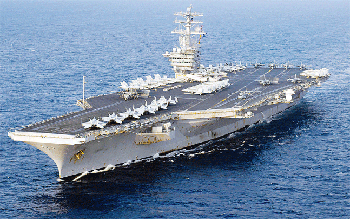India-US-Japan’s Malabar naval exercise is a message gift-wrapped for China
Mangalore Today News Network
July 17, 2017: The F/A-18 super hornet fighter jets line up along the 4.5-acre flight deck of the 98,000-tonne displacement US navy aircraft carrier USS Nimitz in the Bay of Bengal.

The ship is sailing about a hundred nautical miles off the coast of Chennai. One after the other, a dozen aircraft are catapulted into the sky in under two minutes each. The aim is to dominate the skies as the P-8 A and P 8 I Poseidon aircraft of the US and Indian navies carry out long-range maritime reconnaissance and antisubmarine warfare operations to dominate the seas. 21 ships, including two submarines and over 100 aircraft and helicopters of the US, Japan and Indian navies are currently carrying out the most complex naval exercise in the Bay of Bengal in an aim to hunt down enemy submarines.
"This is the most complex exercise undertaken by the three navies together. INS Vikramaditya, India’s aircraft carrier with its MiG-29 K aircraft and P 8 I reconnaissance aircraft are participating in this exercise for the first time. The Japanese maritime defence force has also sent its most potent weapon platform JS Izumo with nine anti-submarine warfare helicopters for the first time.
EXERCISE A MESSAGE TO BELLIGERENT CHINA
"The US Navy has this aircraft carrier, LA class submarine, destroyers and cruisers, fighter aircraft, helicopters and P 8 A for joint submarine hunting and sea domination exercise,’’ says a top officer participating as an observer.
Though on record officers of the three countries insist the operations are all about interoperability and jointmanship to work together from humanitarian aid disaster relief to anti-piracy, scratch beneath the surface they admit the exercise is an attempt to send out a signal to an increasingly belligerent China.
The aim is to checkmate China. "The exercise is designed to advance military to military coordination and capacity to plan and execute tactical operations in multinational environment. There is a live firing gunnery exercises, helicopter cross deck operations and anti submarine warfare,’’ says Rear Admiral William Byrne, Commander of the US Carrier Strike Group.
CHINESE SUBMARINES LURKING IN INDIAN OCEAN
The message, to China, he insists is the same as to the rest of the world and that is to follow international norms. The Indian Navy is in the market hunting for anti-submarine warfare helicopters and on display are the capabilities of the MH 60 R ASW helicopters.
The Chinese navy submarines are increasingly lurking in the Indian ocean region. "We need better technology and more platforms to keep up with the Dragon’s every increasing footprint. This exercise is a step in the right direction,’’ he adds. As the navies refine their interoperability, the message is not lost. Today the three powerful maritime forces are operating in the Indian ocean region. Tomorrow, if required the three navies along with their allies can also operate across the high seas - from north Arabian Sea to the South China sea.
Courtesy: Indiatoday
- Former don Muthappa Rai’s son injured after being shot at in moving car near Bidadi house
- Mulki: Top portion of Bappanadu temple chariot collapses during Rathotsava; none hurt
- Belthangady youth slips to death in Cauvery river
- Kundapur: Speeding Omni fatally knocks down pedestrian
- Snehalaya and Janamaithri Police launch anti-Drug awareness drive at Uppal and Hosangadi
- Mangaluru: Fight will continue till amendments to Waqf Act are withdrawn, say Muslim leaders
- Direction to remove Janivara would have come with the knowledge of the govt., says Poojary
- JEE (Main) second edition results to be announced by April 19: NTA
- Three arrested for raping woman in Mangaluru, say police
- Summer rush: Special trains, Vande Bharat sleeper announced for Mangaluru
- Mangaluru: Yellow alert issued as thunderstorms expected across coastal Karnataka
- Mangaluru: Bride-to-be goes missing a day before wedding in Bolar
- Puttur: Grand Brahmarathotsav at Shri Mahalingeshwara Temple draws thousands with devotion and splendor
- Caste census report politically motivated, says R Ashoka
- PM Modi to visit Saudi Arabia from April 22-23
- 4 dead, many feared trapped as building collapses in Delhi’s Mustafabad
- Kerala teacher acquitted as student confesses fake rape allegation
- CET officials booked for asking students to remove sacred thread at exam centre in Shivamogga
- BJP worker found hanging in Bengaluru outskirts, video message names ‘local leader’
- CET row: Karnataka govt orders probe after students asked to remove sacred thread
- Man who flashed woman, assaulted 7 people arrested in Bengaluru
- FIR against Sunny Deol, Randeep Hooda for offending Christian religious sentiments in Jaat
- 22 maoists surrender before security forces in Chhattisgarh’s Sukma
- Indian Embassy repatriates 4 nationals scammed in Myanmar’s Myawaddy
- ED debunks Bengaluru man’s claims of importing Rs 50-crore wolfdog
- Skills and Competencies Take Center Stage at MSN Dialogue Series
- Court remands Maoist Lakshmi to six-day police custody
- Sandhya Shenoy honored with Society for Materials Chemistry Medal-2024
- White Cornus Apartment in Mangaluru
- City girl wins first place in state-level spell bee competition
- Alleged ‘Love Jihad’ Case in Mangaluru: Woman left home voluntarily, says police
- Girl fatally struck by reckless two-wheeler near Belman
- New residential complex for the judges inaugurated in Mangaluru
- Absconding accused nabbed after 8 years
- Truck with cylinders turns turtle in Beltangady
- Bhoota Kola artist dies of cardiac arrest
- Development of the country should be our goal: Ganesh Karnik
- Container truck gets stuck under Modankap railway bridge
- Truck crushes bike’s pillion rider near BC Road
- Head constable dies of heart attack
- CITY INFORMATION
- TRAVEL
- TOURIST INFORMATION
- HEALTH CARE
- MISCELLANEOUS




 Write Comment
Write Comment E-Mail To a Friend
E-Mail To a Friend Facebook
Facebook Twitter
Twitter  Print
Print 


